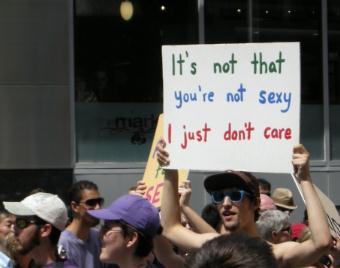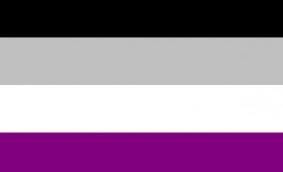
AVEN marches in 2011 Toronto Pride. Credit: Tumblr (Ace up your sleeve)
From the age of 11 or 12, Frances says, she knew there was something “off” about her.
At 17, she fell in love with a man – but felt no sexual attraction. A few years later, she fell in love with a woman – but again, nothing. After spending years in bisexual women’s and lesbian communities, the London, Ontario, resident realized those labels didn’t quite fit. Although she was interested in romance and a self-described sex-positive feminist, Frances simply wasn’t interested in sex. Haunted by stereotypes, she panicked: “I said to a friend I was going to die alone, surrounded by cats.”
Her friend suggested she check the internet for a community for people who want romantic relationships without sex.
Last December, Frances took that advice and discovered the Asexual Visibility and Education Network (AVEN). For more than a decade, the group has educated the public about asexuality and connected tens of thousands of asexual-identified and questioning people with resources and each other.
Like other identity-based communities, AVEN stresses there are as many ways of being asexual as there are asexuals. Some are in non-sexual romantic relationships (monogamous or not), others in sexual relationships, still others single. Some see asexuality as a political, queer or radical identity. Others want nothing to do with politics.
What asexuals share is that they do not experience sexual attraction to other people, and AVEN’s spectacular growth – and scientific data – suggest they’re far from alone. A widely cited 2004 study on sexual behaviour in the UK by Brock University psychology professor Anthony Bogaert suggests about one percent of the population self-described as “never having a sexual attraction.”
In a society many describe as relentlessly sexual, asexuals can also face invisibility, isolation and questions that range from genuinely curious to outright hostile.
May, also from London, describes the scrutiny she faces for being a “happily single” 30-year-old asexual woman. “Aside from ‘Are you gay?'” she says, “the most popular speculation is, ‘Were you abused as a child?'”
May’s experiences point to how assumptions about “normal” desire can affect sexual and asexual people alike, working in tandem with homophobic, sexist and ageist stereotypes. Her knack for sarcasm, she says, is often interpreted as flirtatious. “There is always the irritating subtext of ‘sex,'” she says. “The one that dictates [that] any 30-year-old woman without a ring on her finger who pays a lot of attention to another person is just offering her body to them.”
And despite the work of Bogaert, York University’s Ela Pryzbylo, UK researcher Mark Carrigan and others, academic takes on asexuality have often been silent or silencing. As an undergraduate in a psychology course on human sexuality at a public university in Ontario, Sarah says she found diverse perspectives in the course, ranging from evolutionary biology to social and cultural, yet the text made not one mention of asexuality.
But when Sarah started a dialogue, her professor not only listened to her critiques, but also invited her to give a guest lecture on the topic. Now a graduate student in Toronto, Sarah travels to her alma mater to lecture on asexuality each year. Drawing from psychology, sociology and queer theory, she invites students to consider the role of power and scientific authority in making some identities and practices seem normal and natural and others seem pathological.
Of course, it’s not only straight people who trot out such stereotypes. Nate, who has marched in AVEN’s contingent at Toronto Pride for the last two years and identifies as queer, says as much prejudice can come from corners of the lesbian, gay, bisexual and trans community as from straight people. “A lot of people think, ‘I’m gay, I’m liberal, I’m accepting,’ and then here’s another thing, and there’s a sense of rivalry for no reason.”
A gay friend made a comment about how Frances, who is now in a relationship with an asexual man, “isn’t really queer anymore.” She replied, “I’m still queer; I’m just a few letters back at the end of the line.”
Increasingly, local asexuals are building communities through and beyond the internet and stepping forward to challenge assumptions about sexual norms. Both Toronto and London are now home to regular asexual meet-ups, with more information available through AVEN.
For Frances, asexual communities, like trans communities, could create space for alternative genders and intimacies that aren’t focused primarily on sex. As a self-described queer “doer and joiner,” she is frustrated by the segregation of gay, lesbian and trans communities and sees asexuality as a different path to building queer community. “When only certain narratives are given a stage,” she says, “it does create these huge gaps. I don’t want anybody to feel broken.”
Note: All of the people interviewed in this story asked that their last names not be used in order to protect their privacy.

 Why you can trust Xtra
Why you can trust Xtra


